Dental Cements Important Notes
1. Classification Of Blocks Of Cement
- According To A Setting Reaction
- Acid-base reaction
- Polymerizing cement – resin cement
- Dual-core cement a Tri cure cement
- Based On Application
- Type 1 – luting types of cement
- Type 1 – fine grain for cementation
- Type 2 – medium grain for bases, orthodontic purposes
- Type 2 – restorative application
- Type 3 – liner or bases
- Based on function
2. Silicate
Silicate Composition
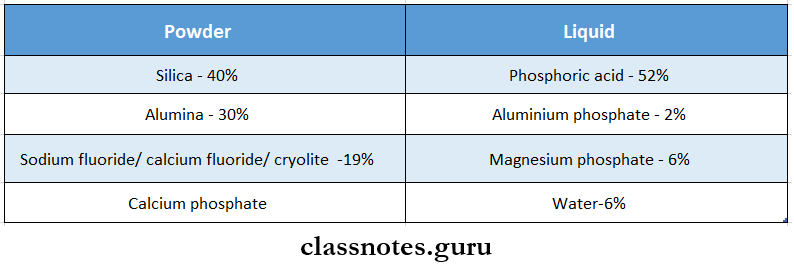
- Silicate Properties
- Compressive strength – 180 Mpa
- Setting time – 3-8 min o Hardness – 70 KHN
- Severe irritant to pulp
- It has high solubility to oral fluids
- It has anti-cariogenic property
- The refractive index is similar to enamel and dentin
- Contra indicated in mouth breathers
- Finishing and polishing should be delayed to several days
- The surface is protected by a coating of varnish
3.
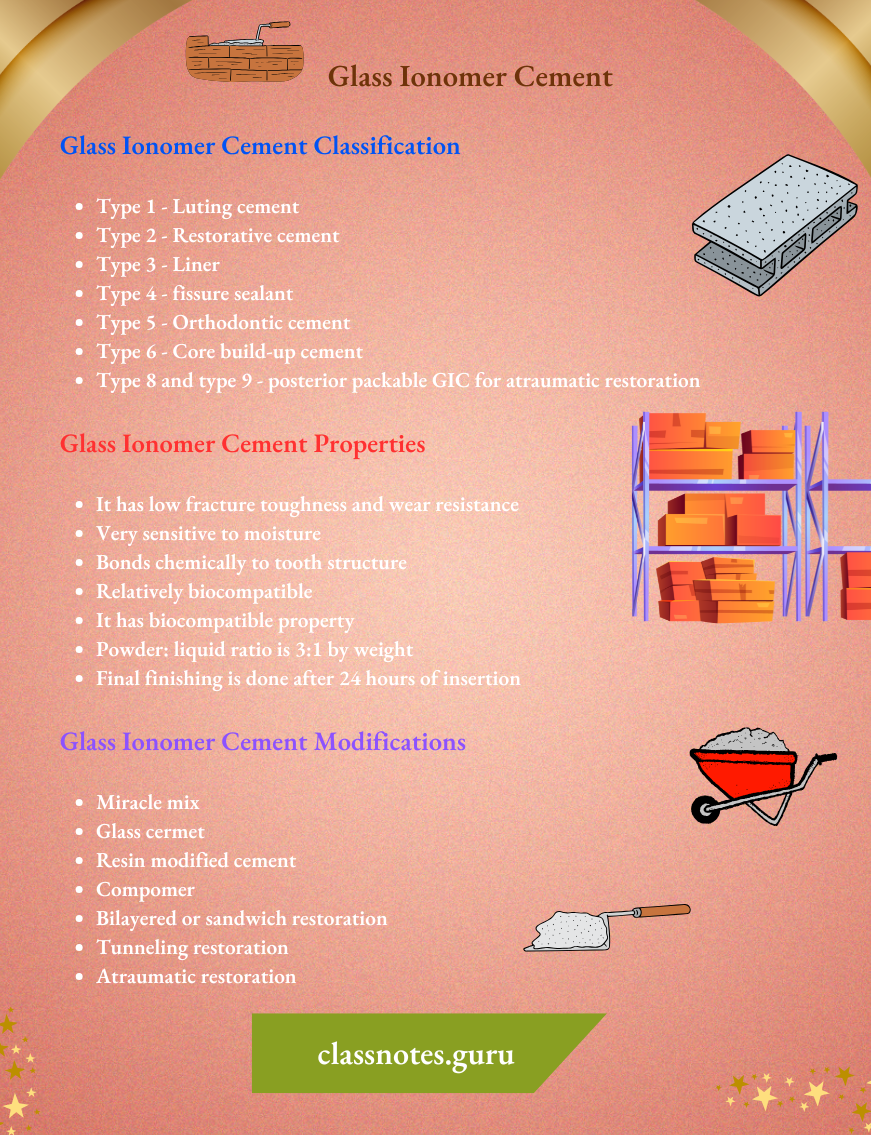
4. Zinc Phosphate Cement
Zinc Phosphate Cement Composition
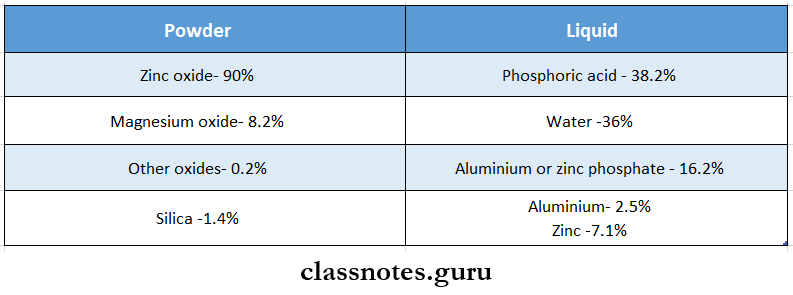
Types Of Dental Cement
- Zinc Phosphate Cement Setting Reaction
- Phosphoric acid reacts with zinc oxide forming zinc phosphate
- Aluminum on liquid forms complexes with phosphoric acid to form zinc alumina phosphate gel
- Prolonged speculation retards the setting reaction
- Adding powder in increments increases the setting and mixing time
- Cooling the mixing slab increases the setting time
5. Zinc Polycarboxylate Cement
Zinc Polycarboxylate Cement Composition


Zinc Polycarboxylate Cement Properties
- Less irritant to pulp
- the pH of the liquid is 1.7
- Cement bonds chemically to the tooth structure due to the chelation of the carboxyl group with calcium on the tooth
- It is a good thermal insulator so can be used as bases
6. Zinc Oxide Eugenol Cement
Zinc Oxide Eugenol Cement Classification
- Type 1 – for temporary restoration
- Type 2 – for permanent restoration
- Type 3 – temporary filling and bases
- Type 4 – cavity liners
Zinc Oxide Eugenol Cement Composition
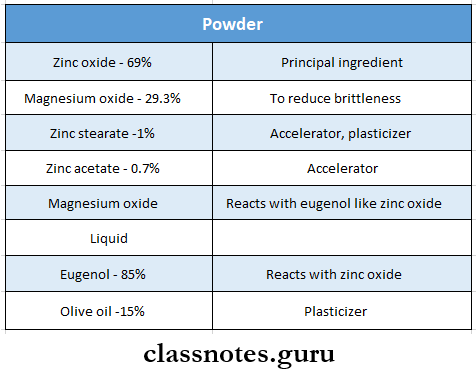
Zinc Oxide Eugenol Cement Properties
- Solubility is highest
- Least irritant
- It has a soothing effect on pulp
- Modified ZOE cement
- EBZ alumina modified
- Polymer-reinforced ZOE cement
- Types of cement containing vanillate esters
7. Calcium Hydroxide Cement
- It is weak cement
- Uses
- For direct and indirect pulp capping
- In apexification
- In Pulpotomy
- As a root canal sealer
- As root canal disinfectant
- As cavity liner and base
Calcium Hydroxide Cement Properties
- Solubility in water is high
- Alkaline in nature
- pH is 11
- It is an antibacterial agent
8. Varnish
Cavity varnish is a solution of one or more resins which when applied onto the cavity walls evaporates leaving a thin resin film that serves as a barrier between the restoration and the dentinal tubules
Varnish Composition
Natural gum such as copal, rosin, or synthetic rosin dissolved in organic solvents such as alcohol, acetone, or ether
Varnish Applications
- In amalgam restoration
- Prevents discoloration by preventing the penetration of silver Ions into the dentin
- Decreases marginal leakage
- As surface coating over GIC cement, silicate
- Over metallic restoration to prevent galvanic shock
Dental Cement And Their Uses
Varnish Contraindications
- Composite resins
- GIC and polycarboxylate restoration
Varnish Properties
- Possesses neither mechanical strength nor provides thermal Insulator
- Insoluble in oral fluids
9. Liner
- A cavity liner is like cavity varnish to provide a barrier against the passage of irritants from cement and to reduce the sensitivity of freshly cut dentin
- They are volatile or aqueous suspensions of zinc oxide or calcium hydroxide that can be applied to the cavity surface
- They neither possess strength nor a thermal insulator
- Calcium hydroxide or GIC liner should be used under composite restoration
- Calcium hydroxide stimulates reparative dentin formation
- ZOE has an obtundent effect on pulp
10. Bases
- It is a thicker layer of cement placed under restoration to
- Encourage recovery of injured pulp
- Protect the pulp from thermal, chemical, and galvanic insult
- Serve as a substitute for dentin that has been destroyed by caries or cavity preparation
Bases Types
- Low strength bases – ZOE, calcium hydroxide
- High-strength bases – zinc phosphate, GIC, polycarboxylate
Bases Properties
- Should have a minimal thickness of 0.75 mm
- Must have sufficient strength to withstand forces of condensation and masticatory stresses
- Does not prevent microleakage and acid penetration
- With zinc phosphate as a base, a sealant is placed first followed by a base
- With calcium hydroxide, ZOE, GIC, or polycarboxylate, the base is placed first followed by a sealant
11. Fluoride-Releasing Cement
- Fluoride-releasing cements are silicate, GIC, silicophosphate, and polycarboxylate
- Fluoride has anti-cariogenic properties
- It inhibits demineralization and enhances remineralization of carious enamel
- GIC has the highest fluoride release property
12. Factors Affecting The Setting Time Of Cement
- Cooling of mixing slab
- Decreased powder-liquid ratio
- Prolonged mixing time
- Loss of water from the liquid
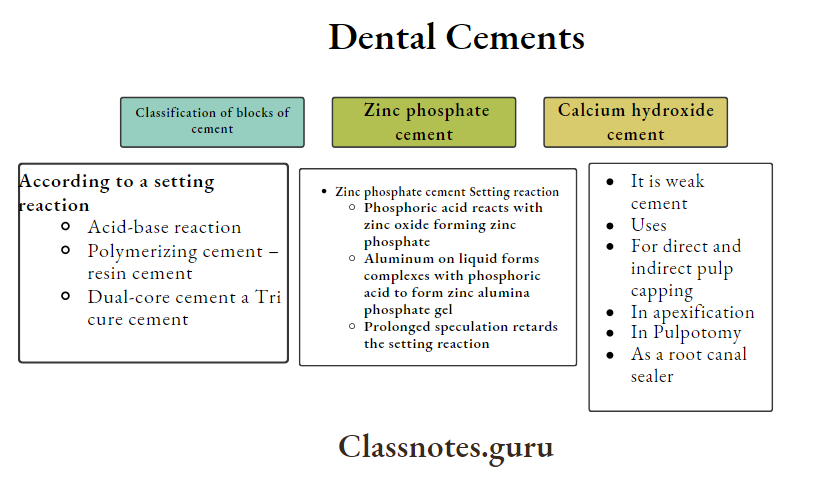
Properties Of Dental Cement
Dental Cement Long Essays
Question 1. Describe the composition, properties, and manipulation of glass ionomer cement.
Answer:
Glass Ionomer Cement:
Glass ionomer cement is colored cardiogenic restorative material
Glass Ionomer Cement Composition:
- Glass Ionomer Cement Powder
- It is an acid-soluble calcium fluoro aluminosilicate glass

Glass Ionomer Cement Liquid

Glass Ionomer Cement Properties:
- Physical properties

- Biological Properties Or Anti-Cariogenic Properties
- Glass ionomer cement releases fluoride in comparable amounts
- Carried out for an extended period
- This is taken up by enamel
- Thus inhibits caries
- Moreover, they have the potential to reduce the infiltration of oral fluids at the cement tooth interface
- Thus preventing secondary caries
- Biocompatibility
- It is biocompatible
- Has a mild pulpal response
- Adhesion
- It adheres well to enamel and dentin
- Esthetics
- Inferior to silicates and composites
- Lacks translucency
Glass Ionomer Cement Manipulation:
- Tooth Surface Preparation
- Pumice slurry is used to remove the smear layer
- Conditioning is done
- Etching with 37% phosphoric acid for 10-20 sec
- Rinsing with water for 20-30 sec
- The next surface is dried but not desiccated
- Preparation Of Material
- Powder-liquid ratio recommended by the manufacturer is followed
- Powder and liquid are dispensed over a paper pad just before mixing
- The powder is divided into 2 or more increments
- The powder is incorporated rapidly into the liquid using a stiff plastic spatula
- Subsequent increments are incorporated and mixed using a folding technique
- Mixing time-45 sec
- Placement Of Material
- The cavity should be slightly overfilled
- The surface should be covered with a plastic matrix to protect the setting cement from losing or gaining water during the initial set
- The matrix is left in place for at least 5 min
- Upon removal of the matrix, the surface is again protected with
- Special varnish
- Unfilled light-cured resin bonding agent
- Petroleum jelly
- Finishing of restoration
- Should be delayed for 24 hours
Luting Cements In Dentistry
Question 2. Classify dental cement. Write the composition, properties, and uses of polycarboxylate cements.
Answer:
Dental Cement Classification:
- According To The Setting Reaction
- Acid-base reaction cement
- Formulated as powder and liquid
- Polymerizing cement
- Sets by polymerizing reaction
- Example. Resin cement
- Dual-core cement
- Set by acid-base reaction and by light-activated or chemically activated polymerization mechanism
- Tri cure cement
- Utilizes all three mechanisms for hardening
- Based On Application
- Type 1- luting cement
- Type 1- fine grain for cementation
- Type 2- medium grain for bases, orthodontic purpose
- Type 2- restorative application
- Type 3- liner or base application
- Based On Functions

Zinc Polycarboxylate Cement:
Zinc Polycarboxylate Cement Composition:
- Zinc Polycarboxylate Cement Powder
- Zinc oxide- the basic ingredient
- Magnesium oxide
- Modifier
- Aids in sintering
- Bismuth and aluminum oxide- occur in small amounts
- Stannous fluoride
- Increases strength
- Modifies setting time
- Imparts anti-cariogenic properties
- Zinc Polycarboxylate Cement Liquid
- Polyacrylic acid
- The copolymer of acrylic acid with other unsaturated carboxylic acids
Zinc Polycarboxylate Cemen Properties: Physical properties

- Zinc Polycarboxylate Cement Biocompatibility
- Mild pulpal response
- Adhesion
- Excellent adhesion
- Polyacrylic acid is believed to react with calcium ions via carboxyl groups on the surface of enamel and dentin
- The bond strength of enamel is greater
- Optical properties
- It is very opaque
- Thermal properties
- It is a thermal insulator
Zinc Polycarboxylate Cement Uses:
- Cementation of restoration
- As bases and liners
- As intermediate restoration
- Luting of permanent restoration
- In orthodontics- the cementation of bands
- In endodontics- as root canal filling material
Question 3. Mention the types of glass ionomer cement. Add a note on the mechanism of adhesion of glass ionomer to the tooth.
Answer:
Types of Glass Ionomer Cement:
- Type 1- for luting
- Type 2- for restoration
- Type 3- as liner and bases
Glass Ionomer Cement Mechanism of Adhesion:
- The exact mechanism has not yet been identified
- Glass ionomer bonds chemically
- It primarily involves the chelation of carboxyl groups of the polyacids with the calcium in the apatite of enamel and dentin
- The bond strength of enamel is higher than that of dentin because
- Greater inorganic content of enamel
- Greater homogeneity
Glass Ionomer Cement Uses
Question 4. Give the biological properties of glass ionomer. Add a note on the recent modifications of GIC.
Answer:
Glass Ionomer Cement:
Glass Ionomer Cement Biological Properties:
- Glass ionomer cement releases fluoride in comparable amounts
- Carried out for an extended period
- This is taken up by enamel
- Thus inhibits caries
- Moreover, they have the potential to reduce the infiltration of oral fluids at the cement tooth interface
- Thus preventing secondary caries
Recent Modification of GIC:
- Introduced to improve
- Strength
- Fracture toughness
- Resistance to wear
- They are
1. Metal-modified GIC
- Metal-modified GIC Types
- Silver alloy admixed
- Spherical amalgam alloy powder is mixed with type 2 GIC powder
- Cermet
- Silver particles are bonded to glass particles
- Metal-modified GIC Uses
- Restoration of small class 1 cavity
- For the core build-up of grossly destructed teeth
2. Resin-modified GIC
- Resin-modified GIC Types
- Resin-modified glass ionomer cement
- Compomers or polyacid modified composites
- Resin-modified GIC Uses
- Restoration of class 1,3 or 5 cavities
- As bases and liners
- As adhesives for orthodontic brackets
- Cementation of crowns and FPDs
- Repair of damaged amalgam cores or cusps
- Retrograde root filling
- Resin-modified GIC Composition
- Powder
- Fluorosilicate glass
- Initiator
- Liquid
- 15-25% resin component (HEMA)
- Polyacrylic acid
- Water
Question 5. State the ideal requisites of luting cement. Give the composition, chemistry of setting, and properties of glass ionomer cement.
Answer:
Ideal Requisites Of Luting Cement:
1. Ideal Requisites Of Luting Cement Biological
- Should be nontoxic
- Should be non carcinogenic
- Should not cause any systemic reaction
- Should be cariostatic
2. Ideal Requisites Of Luting Cement Chemical
- Should be chemically inert
- Should have negligible solubility to oral fluids
- Should bond chemically to enamel and dentin
- pH should be neutral
3. Ideal Requisites Of Luting Cement Rheological
- Should have low film thickness to enable easy flow
- Should have longer mixing and working time
- Should have a shorter setting time
4. IIdeal Requisites Of Luting Cement Mechanical
- Should have high compressive strength, tensile strength, and modulus of elasticity
- Should exhibit minimum dimensional changes
5. Ideal Requisites Of Luting Cement Thermal
- Should be a good thermal insulator
- The coefficient of thermal expansion should be similar to the tooth
6. Ideal Requisites Of Luting Cement Optical
- Should not alter the color of the tooth or prosthesis
- Should have adequate radio parity
7. Ideal Requisites Of Luting Cement Miscellaneous
- Should be easy to manipulate
- Inexpensive
- Should have a longer shelf life
Glass Ionomer Cement Composition:
- Powder:
- It is an acid-soluble calcium fluoro aluminosilicate glass
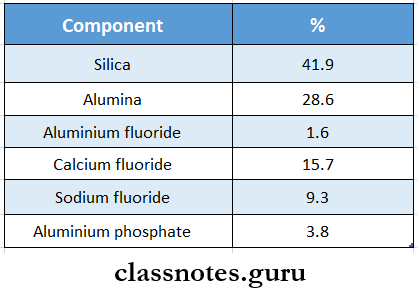
Chemistry Of Setting
1. Chemistry Of Setting Leaching Of Ions
- When GIC powder and liquid are mixed, the acid attacks the glass particles
- This causes the leaching of calcium, aluminum, sodium, and fluoride ions over the surface

2. Chemistry Of Setting Hydration
- Water slowly hydrates the matrix
- This adds to the strength of the cement
3. Chemistry Of Setting Silica gel sheath
- The unreacted glass particles are sheathed by a silica gel
- This is formed by the leached ions
- Biological Properties Or Anti-Cariogenic Property
- Glass ionomer cement releases fluoride in comparable amounts
- Carried out for an extended period
- This is taken up by enamel
- Thus inhibits caries
- Moreover, they have the potential to reduce the infiltration of oral fluids at the cement tooth interface
- This prevents secondary caries
- Biocompatibility
- It is biocompatible
- Has a mild pulpal response
- Adhesion
- It adheres well to enamel and dentin
- Esthetics
- Inferior to silicates and composites
- Lacks translucency
Zinc Phosphate Cement In Dentistry
Question 6. Classify Dental cements based on their uses and describe the composition, setting reaction, and properties of Zinc Phosphate Cement.
Answer:
Classification Of Dental Cement:
Dental Cement Based on Their Uses:
- Type 1 – Luting cement
- Type 1 – fine grain for cementation
- Type 2 – medium grain for bases, orthodontic purposes
- Type 2 – restorative application
- Type 3 – liner or base application
Zinc Phosphate Powder:

Zinc Phosphate Liquid:

Zinc Phosphate Setting Reaction:
- When the powder is mixed with liquid
- Phosphoric acid attacks the surface of particles and releases zinc ions
- Aluminum combines with phosphoric acid and zinc ions
- Results in the formation of zinc aluminophosphate gel
- The reaction is exothermic
Zinc Phosphate Properties:

Dental Cements Short Essays
Question 1. Calcium hydroxide
Answer:
Calcium Hydroxide
Calcium Hydroxide is a relatively weak cement
Calcium Hydroxide Uses:
- For direct pulp capping
- For indirect pulp capping
- As low-strength bases
- In apexification
Calcium Hydroxide Composition:
Calcium Hydroxide Base Paste
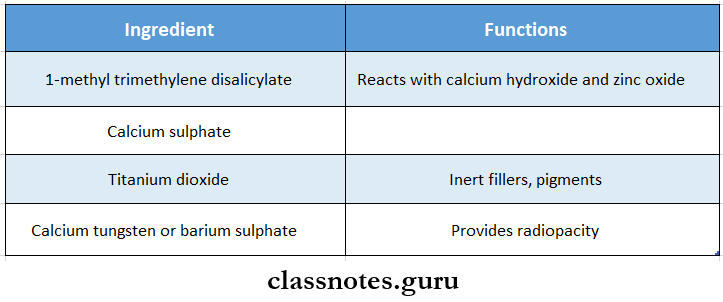
Calcium Hydroxide Catalyst Paste

Calcium Hydroxide Properties:
- Mechanical properties
- Compressive strength-10-27 Mpa
- Tensile strength-1 Mpa
- Modulus of elasticity-0.37%
- Thermal properties
- Provide thermal insulation in thick layers
- Solubility
- Solubility is high- 0.4-7.8%
- Biological properties
- It is alkaline in nature
- Adhesion
- Does not adhere in the presence of blood, water, or saliva
Dental Cements PDF
Question 2. Liners And Bases
Answer:
Liners And Bases
- Liners are fluid materials that adapt more readily to all aspects of a tooth
- Creates uniform even surface
- Aids in the adaptation of materials such as amalgam
- Has poor strength so cannot be used alone
Liners And Bases Indications:
- Pulpal protection- Provide a barrier against the passage of irritants from cement
- Formation of reparative dentin- reduces the sensitivity of freshly cut dentin
Liners And Bases Materials Used:
- ZOE
- Calcium hydroxide
- Flowable composites
- GIC
Liners And Bases Bases:
- A base is a layer of cement placed beneath a permanent restoration to encourage recovery of injured pulp
- It is applied in much thicker layers
Liners And bases Functions:
- Protects the pulp against thermal injury, galvanic shock, chemical irritation
- Withstand condensation forces during placement of a restoration
- Resist fracture under any masticatory stresses induced on the restorations
- Serve as a substitute for protective dentin
Liners And Bases Types:
- High strength bases
- Zinc phosphate,
- Zinc Polycarboxylate
- GIC,
- Reinforced ZOE
- Low strength bases
- Calcium hydroxide
- ZOE
Liners and Bases Properties:
- Provide thermal protection to pulp
- Serve s barrier against penetration of irritants
- Have a beneficial effect on pulp
- Have sufficient strength
Question 3. Cavity varnish
Answer:
Cavity Varnish
Cavity Varnish is a solution of one or more resins which when applied onto the surface, evaporates leaving a thin resin film
Cavity Varnish Composition:
Natural gum such as copal, rosin, or synthetic resin dissolved in an organic solvent like alcohol, acetone, or ether
Cavity Varnish Manipulation:
- Applied using a brush or small pellet
- Several thin layers are applied
- Each layer is allowed to dry before applying next
- On drying it produces small pinholes which get filled by the next layer
Cavity Varnish Advantages:
- Improves the sealing ability of amalgam
- Reduces post-operative sensitivity
- Prevents discoloration of tooth
Cavity Varnish Indications:
- Reduces pulpal irritation
- Reduces infiltration of irritating fluids through marginal areas
- Prevents penetration of corrosion products of amalgam into dentinal tubules
- Reduces tooth discoloration
- Used as a surface coating over certain restorations to protect from dehydration
- Protect against galvanic shock when applied over metallic restorations
- Fluoride-containing vanishes releases Fluoride
Cavity Varnish Contraindications:
- Under composite resin
- Under GIC
Advantages Of Dental Cements
Question 4. Resin-modified glass ionomer
Answer:
Resin-Modified Glass Ionomer
- Introduced as Vitreband (3M)
- Incorporate the best properties of both GIC and composite resin
Resin-Modified Glass Ionomer Composition:
- Powder
- Fluorosilicate glass
- Initiator
- Liquid
- 15-25% resin component (HEMA)
- Polyacrylic acid
- Water
Resin-Modified Glass Ionomer Advantages:
- Long working time
- Good adaptation
- Chemical adhesion
- Fluoride release
- Improved aesthetics
- Good strength
Resin-Modified Glass Ionomer Disadvantages:
- Polymerization shrinkage
- Limited depth of cure
Question 5. Uses of glass ionomer cement
Answer:
Glass Ionomer Cement Uses:
- As pit and fissure sealant
- Due to anticariogenicity and adhesive properties
- As liner and bases
- Beneath composite and amalgam
- As luting agents
- For cementation of crowns, bridges, veneers, and orthodontic bands
- As orthodontic bracket adhesive
- For restoration of class 3 and class 5 lesions
- Fissure sealing
- Restoration of root caries
- High caries risk patients
- Temporary restoration
- Core build-up
- Atraumatic restorative treatment
Question 6. Recent advances in glass ionomers
Answer:
1. Glass ionomers Metal-modified GIC
- Metal-modified GIC Types
- Silver alloy admixed
- Spherical amalgam alloy powder is mixed with type IIGIC powder
- Cermet
- Silver particles are bonded to glass particles
- Metal-modified GIC Uses
- Restoration of small class 1 cavity
- For the core build-up of grossly destructed teeth
2. Glass ionomers Resin-modified GIC
- Resin-modified GIC Types
- Resin-modified glass ionomer cement
- Compomers or polyacid modified composites
- Resin-modified GIC Uses
- Restoration of class 1,3 or 5 cavities
- As bases and liners
- As adhesives for orthodontic brackets
- Cementation of crowns and FPDs
- Repair of damaged amalgam cores or cusps
- Retrograde root filling
Resin-modified GIC Composition:
- Powder
- Fluorosilicate glass
- Initiator
- Liquid
- 15-25% resin component (HEMA)
- Polyacrylic acid
- Water
Dental Cements Classification Chart
Question 7. Classification of glass ionomers
Answer:
Glass ionomers Classification:
- Type 1- for luting
- Type 2- for restoration
- Type 3- as liner and bases
Question 8. Luting cement
Answer:
Luting implies the use of a moldable substance to seal a space or to cement two components together
Luting cement The cement used is:
- Zinc phosphate
- Zinc oxide eugenol
- Zinc polycarboxylate
- Glass ionomer cement
- Resin modified GIC
- Compomer
- Resin cement
Luting Cement Factor Affecting its Selection:
- Working time
- Setting time
- Consistency
- Ease of removal of excess material
Question 9. Root canal sealants
Answer:
Root Canal Sealants Requirements:
- Should be tacky
- Should create a hermetic seal
- Should be radiopaque
- Should be miscible
- Should be bacteriostatic
- Should set slowly
- Should be insoluble in oral fluids
- Should not shrink
- Should not stain
Root Canal Sealants Functions:
- Antimicrobial agent
- Lubricant
- Binding agent
- Fills die space between material and canal walls
- As obturating material
- Give radiopacity
Root Canal Sealants Classification:
- Eugenol
- Silver containing
- Kerr sealer
- Silver free
- Grossman’s sealer
- Medicated
- Iodoform
- Non-eugenol
- Hydron
- Glass ionomer
- Diaket
Question 10. Glass cermets
Answer:
Glass Cermets
- Introduced by McLean and Gasser
- It is a fusion of glass ionomer to powder like silver or gold
Glass Cermets Manufacture:
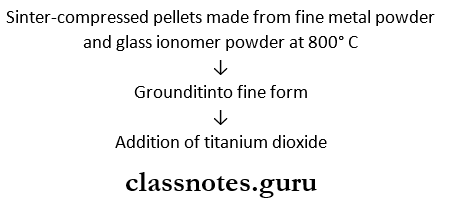
Glass Cermets Advantages:
- Better abrasion resistance
- Higher flexure strength
Glass Cermets Disadvantage
Poor esthetics
Question 11. Gutta-percha
Answer:
Gutta-percha
Gutta-percha is an endodontic filling material
Gutta-percha Composition:

Gutta-percha Forms:
- Alpha
- Beta
- Amorphous
Gutta-percha Advantages:
- Compatibility
- Inertness
- Dimensional stable
- Tissue tolerance
- Radiopacity
- Plasticity
- Dissolve in some solvent
Gutta-percha Disadvantages:
- Lack of rigidity
- Lack of adhesiveness
- Easily displaced
Question 12. Zinc phosphate cement
Answer:
Zinc Phosphate Cement
Zinc phosphate is the oldest of the luting cement
Zinc Phosphate Cement Manipulation:
- A cool mixing slab should be employed to prolong working and setting time
- The powder is divided into increments
- The liquid is dispensed just before mixing
- Mixing is initiated by the addition of a small amount of powder with brisk speculation
- Each increment is mixed for 15-20 sec
- A large area of the slab is used to dissipate exothermic heat
- Completion of mixing usually requires approximately 1.5-2 min
Dental Cements MCQs
Dental Cement Short Question And Answers
Question 1. Manipulation of zinc phosphate cement
Answer:
Manipulation Of Zinc Phosphate Cement
- A cool mixing slab should be employed to prolong working and setting time
- The powder is divided into increments
- The liquid is dispensed just before mixing
- Mixing is initiated by the addition of a small amount of powder with brisk speculation
- Each increment is mixed for 15-20 sec
- A large area of the slab is used to dissipate exothermic heat
- Completion of mixing usually requires approximately 1.5-2 min
Question 2. Polycarboxylate cement
Answer:
Polycarboxylate Cement Composition
- Polycarboxylate Cement Powder
- Zinc oxide- the basic ingredient
- Magnesium oxide
- Modifier
- Aids in sintering
- Bismuth and aluminum oxide- occur in small amounts
- Stannous fluoride
- Increases strength
- Modifies setting time
- Imparts anti-cariogenic properties
- Polycarboxylate Cement Liquid
- Polyacrylic acid
- The copolymer of acrylic acid with other unsaturated carboxylic acids
Polycarboxylate Cement Uses:
- Cementation of restoration
- As bases and liners
- As intermediate restoration
- Luting of permanent restoration
- In orthodontics- the cementation of bands
- In endodontics- as root canal filling material
Question 3. Uses Of Glass Ionomer Cement
Answer:
Uses Of Glass Ionomer Cement
- As pit and fissure sealant
- Due to anticariogenicity and adhesive properties
- As liner and bases
- Beneath composite and amalgam
- As luting agents
- For cementation of crowns, bridges, veneers, and orthodontic bands
- As orthodontic bracket adhesive
- For restoration of class 3 and class 5 lesions
- Fissure sealing
- Restoration of root caries
- High caries risk patients
- Temporary restoration
- Core build-up
- Atraumatic restorative treatment
Question 4. Pulp protective cement
Answer:
Pulp Protective Cement
- Pulp protective cement is
- Cavity varnish
- Cavity liners
- Bases
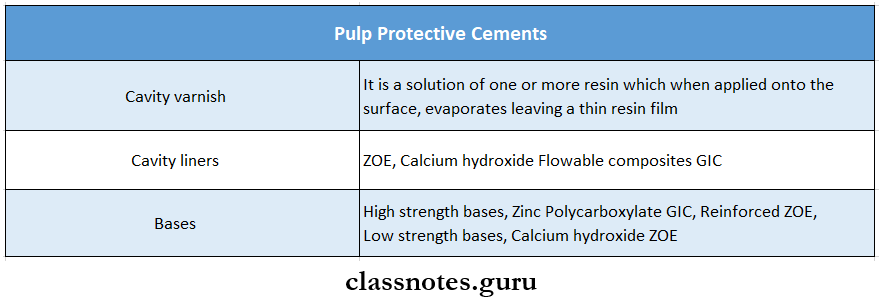
Question 5. Metal modified GIC
Answer:
- Metal-modified GIC Types:
- Silver alloy admixed
- Spherical amalgam alloy powder is mixed with type 2 GIC powder
- Cermet
- Silver particles are bonded to glass particles
- Metal-modified GIC Uses:
- Restoration of small class 1 cavity
- For the core build-up of grossly destructed teeth
Dental Cements MCQs
Question 6. Cavity varnish
Answer:
Cavity varnish
It is a solution of one or more resins which when applied onto the surface, evaporates leaving a thin resin film
Cavity varnish Composition:
Natural gum such as copal, rosin, or synthetic resin dissolved in an organic solvent like alcohol, acetone, or ether
Cavity varnish Indications:
- Reduces pulpal irritation
- Reduces infiltration of irritating fluids through marginal areas
- Prevents penetration of corrosion products of amalgam into dentinal tubules
- Reduces tooth discoloration
- Used as a surface coating over certain restorations to protect from dehydratio
- Protect against galvanic shock when applied over metallic restorations
- Fluoride-containing vanishes releases Fluoride
Question 7. Cavity liners
Answer:
Cavity liners
- Liners are fluid materials that adapt more readily to all aspects of a tooth
- Creates uniform even surface
- Aids in the adaptation of materials such as amalgam
- Has poor strength so cannot be used alone
Cavity liners Indications:
- Pulpal protection- Provide a barrier against the passage of irritants from cement
- Formation of reparative dentin- reduces the sensitivity of freshly cut dentin
Cavity liners Materials Used:
- ZOE
- Calcium hydroxide
- Flowable composites
- GIC
Question 8. Uses of Polycarboxylate
Answer:
Uses of Polycarboxylate
- Cementation of restoration
- As bases and liners
- As intermediate restoration
- Luting of permanent restoration
- In orthodontics- the cementation of bands
- In endodontics- as root canal filling material
Question 9 Uses of calcium hydroxide
Answer:
Uses Of Calcium Hydroxide
- For direct pulp capping
- For indirect pulp capping
- As low-strength bases
- In apexification
Question 10. Intermediate restorative materials
Answer:
Intermediate Restorative Materials Objectives:
- Maintain esthetics
- Act as a space maintainer
- Allow functioning
- Determine occlusion
- Establish phonetics
- Seal and insulate the prepared tooth
- Prevent passive eruption of the tooth
- Prevent pathologic migration
Intermediate Restorative Materials Requirements:
- Good marginal adaptation
- Optimal strength
- Plaque resistant surface
- Economical
- Easy to manipulate
- Dimensionally stable
Intermediate Restorative Materials Purpose:
- Pulp protection
- Act as a sedative
- Soft tissue protection
- Protect weakened tooth protection
- Maintain the esthetics
Intermediate Restorative Materials Used:
- For intra-coronal preparation
- Guttapercha
- Zinc oxide eugenol
- Zinc phosphate
- Zinc polycarboxylate
- Glass ionomer
- Calcium hydroxide
- For extra coronal
- Polycarbonate crown
- Aluminum cylinder
- Stainless steel crown
- Celluloid crown
- Indirect acrylic restoration
Question 11. Biological property of silicate cement
Answer:
Biological Property Of Silicate Cement
- The incidence of secondary caries with silicates is less
- Proximal caries occurrence is less
- The anti-cariogenic property is due to the presence of 15% fluoride in the cement
- Fluoride release is slow and occurs throughout the life of the restoration
- Thus it was used as an anti-cariogenic agent before GIC
Question 12. Advantages and disadvantages of zinc Polycarboxylate cement.
Answer:
Zinc Polycarboxylate Cement Advantages:
- Comparatively less pulpal irritant
- Chemical bond to the tooth
Zinc Polycarboxylate Cement Disadvantages:
Limited fluoride released when compared to GIC
